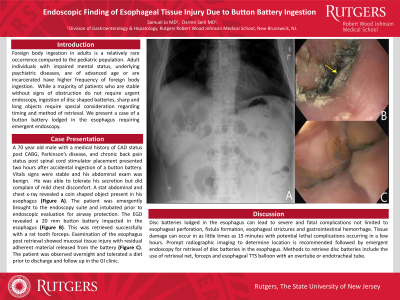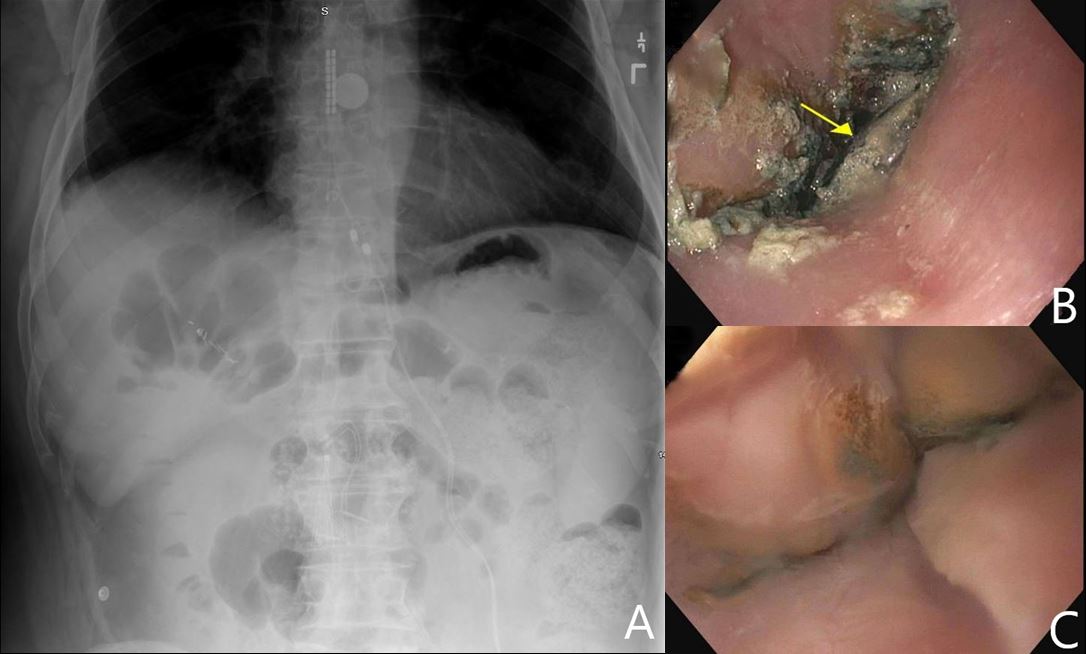Tuesday Poster Session
Category: Esophagus
P4039 - Endoscopic Finding of Esophageal Tissue Injury Due to Button Battery Ingestion
Tuesday, October 29, 2024
10:30 AM - 4:00 PM ET
Location: Exhibit Hall E

Has Audio

Samuel Y. Jo, MD
Robert Wood Johnson Medical School, Rutgers University
New Brunswick, NJ
Presenting Author(s)
Samuel Y. Jo, MD, Darren Seril, MD, PhD
Robert Wood Johnson Medical School, Rutgers University, New Brunswick, NJ
Introduction: Foreign body ingestion in adults is a relatively rare occurrence compared to the pediatric population. Adults individuals with impaired mental status, underlying psychiatric diseases, of advanced age or are incarcerated have higher frequency of foreign body ingestion. While a majority of patients who are stable without signs of obstruction do not require urgent endoscopy, ingestion of disc shaped batteries, sharp and long objects require special consideration regarding timing and method of retrieval. We present a case of a button battery lodged in the esophagus requiring emergent endoscopy.
Case Description/Methods: A 70 year old male with a medical history of CAD status post CABG, Parkinson’s disease, and chronic back pain status post spinal cord stimulator placement presented two hours after accidental ingestion of a button battery. Vitals signs were stable and his abdominal exam was benign. He was able to tolerate his secretion but did complain of mild chest discomfort. A stat abdominal and chest x-ray revealed a coin shaped object present in his esophagus (Figure A). The patient was emergently brought to the endoscopy suite and intubated prior to endoscopic evaluation for airway protection. The EGD revealed a 20 mm button battery impacted in the esophagus (Figure B). This was retrieved successfully with a rat tooth forceps. Examination of the esophagus post retrieval showed mucosal tissue injury with residual adherent material released from the battery (Figure C). The patient was observed overnight and tolerated a diet prior to discharge and follow up in the GI clinic.
Discussion: Disc batteries lodged in the esophagus can lead to severe and fatal complications not limited to esophageal perforation, fistula formation, esophageal strictures and gastrointestinal hemorrhage. Tissue damage can occur in as little times as 15 minutes with potential lethal complications occurring in a few hours. Prompt radiographic imaging to determine location is recommended followed by emergent endoscopy for retrieval of disc batteries in the esophagus. Methods to retrieve disc batteries include the use of retrieval net, forceps and esophageal TTS balloon with an overtube or endotracheal tube.

Disclosures:
Samuel Y. Jo, MD, Darren Seril, MD, PhD. P4039 - Endoscopic Finding of Esophageal Tissue Injury Due to Button Battery Ingestion, ACG 2024 Annual Scientific Meeting Abstracts. Philadelphia, PA: American College of Gastroenterology.
Robert Wood Johnson Medical School, Rutgers University, New Brunswick, NJ
Introduction: Foreign body ingestion in adults is a relatively rare occurrence compared to the pediatric population. Adults individuals with impaired mental status, underlying psychiatric diseases, of advanced age or are incarcerated have higher frequency of foreign body ingestion. While a majority of patients who are stable without signs of obstruction do not require urgent endoscopy, ingestion of disc shaped batteries, sharp and long objects require special consideration regarding timing and method of retrieval. We present a case of a button battery lodged in the esophagus requiring emergent endoscopy.
Case Description/Methods: A 70 year old male with a medical history of CAD status post CABG, Parkinson’s disease, and chronic back pain status post spinal cord stimulator placement presented two hours after accidental ingestion of a button battery. Vitals signs were stable and his abdominal exam was benign. He was able to tolerate his secretion but did complain of mild chest discomfort. A stat abdominal and chest x-ray revealed a coin shaped object present in his esophagus (Figure A). The patient was emergently brought to the endoscopy suite and intubated prior to endoscopic evaluation for airway protection. The EGD revealed a 20 mm button battery impacted in the esophagus (Figure B). This was retrieved successfully with a rat tooth forceps. Examination of the esophagus post retrieval showed mucosal tissue injury with residual adherent material released from the battery (Figure C). The patient was observed overnight and tolerated a diet prior to discharge and follow up in the GI clinic.
Discussion: Disc batteries lodged in the esophagus can lead to severe and fatal complications not limited to esophageal perforation, fistula formation, esophageal strictures and gastrointestinal hemorrhage. Tissue damage can occur in as little times as 15 minutes with potential lethal complications occurring in a few hours. Prompt radiographic imaging to determine location is recommended followed by emergent endoscopy for retrieval of disc batteries in the esophagus. Methods to retrieve disc batteries include the use of retrieval net, forceps and esophageal TTS balloon with an overtube or endotracheal tube.

Figure: Figure A: Abdominal X-ray with circular opaque object in esophagus
Figure B: EGD with lodged button battery
Figure C: EGD post removal of button battery
Figure B: EGD with lodged button battery
Figure C: EGD post removal of button battery
Disclosures:
Samuel Jo indicated no relevant financial relationships.
Darren Seril indicated no relevant financial relationships.
Samuel Y. Jo, MD, Darren Seril, MD, PhD. P4039 - Endoscopic Finding of Esophageal Tissue Injury Due to Button Battery Ingestion, ACG 2024 Annual Scientific Meeting Abstracts. Philadelphia, PA: American College of Gastroenterology.
